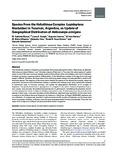Por favor, use este identificador para citar o enlazar este ítem:
http://www.alice.cnptia.embrapa.br/alice/handle/doc/1047889Registro completo de metadatos
| Campo DC | Valor | Lengua/Idioma |
|---|---|---|
| dc.contributor.author | MURÚA, M. G. | pt_BR |
| dc.contributor.author | CAZADO, L. E. | pt_BR |
| dc.contributor.author | CASMUZ, A. | pt_BR |
| dc.contributor.author | HERRERO, M. I. | pt_BR |
| dc.contributor.author | VILLAGRÁN, M. E. | pt_BR |
| dc.contributor.author | VERA, A. | pt_BR |
| dc.contributor.author | SOSA-GOMEZ, D. R. | pt_BR |
| dc.contributor.author | GASTAMINZA, G. | pt_BR |
| dc.date.accessioned | 2016-06-27T11:11:11Z | pt_BR |
| dc.date.available | 2016-06-27T11:11:11Z | pt_BR |
| dc.date.created | 2016-06-27 | pt_BR |
| dc.date.issued | 2016 | pt_BR |
| dc.identifier.citation | Journal of Insect Science, v. 16, n. 1, p. 1-7, Jun. 2016. | pt_BR |
| dc.identifier.issn | 1536-2442 | pt_BR |
| dc.identifier.uri | http://www.alice.cnptia.embrapa.br/alice/handle/doc/1047889 | pt_BR |
| dc.description | The Heliothinae complex in Argentina encompasses Helicoverpa gelotopoeon (Dyar), Helicoverpa zea (Boddie), Helicoverpa armigera (Hu ̈ bner), and Chloridea virescens (Fabricius). In Tucum an, the native species H. gelotopoeon is one of the most voracious soybean pests and also affects cotton and chickpea, even more in soybean-chickpea succession cropping systems. Differentiation of the Heliothinae complex in the egg, larva, and pupa stages is difficult. Therefore, the observation of the adult wing pattern design and male genitalia is useful to differentiate species. The objective of this study was to identify the species of the Heliothinae complex, determine population fluctuations of the Heliothinae complex in soybean and chickpea crops using male moths collected in pheromone traps in Tucuman province, and update the geographical distribution of H. armigera in Argentina. The species found were H. gelotopoeon, H. armigera, H. zea , and C. virescens. Regardless of province, county, crop, and year, the predominant species was H. gelotopoeon . Considering the population dynamics of H. gelotopoeon and H. armigera in chickpea and soybean crops, H. gelotopoeon was the most abundant species in both crops, in all years sampled, and the differences registered were significant. On the other hand, according to the Sistema Nacional Argentino de Vigilancia y Monitoreo de Plagas (SINAVIMO) database and our collections, H. armigera was recorded in eight provinces and 20 counties of Argentina, and its larvae were found on soybean, chickpea, sunflower crops and spiny plumeless thistle (Carduus acanthoides). This is the first report of H. armigera in sunflower and spiny plumeless thistle in Argentina. | pt_BR |
| dc.language.iso | por | pt_BR |
| dc.rights | openAccess | pt_BR |
| dc.title | Species from the Heliothinae complex (Lepidoptera: noctuidae) in Tucuman, Argentina, an update of geographical distribution of Helicoverpa armigera. | pt_BR |
| dc.type | Artigo de periódico | pt_BR |
| dc.date.updated | 2016-07-14T11:11:11Z | pt_BR |
| dc.subject.thesagro | Praga de planta | pt_BR |
| dc.subject.thesagro | Soja | pt_BR |
| dc.subject.thesagro | Inseto | pt_BR |
| dc.subject.thesagro | Entomologia | pt_BR |
| dc.subject.thesagro | Flutuação populacional | pt_BR |
| dc.subject.thesagro | Lagarta | pt_BR |
| dc.subject.nalthesaurus | Crop entomology | pt_BR |
| dc.subject.nalthesaurus | Soybeans | pt_BR |
| dc.subject.nalthesaurus | Plant pests | pt_BR |
| dc.subject.nalthesaurus | Geographical distribution | pt_BR |
| dc.subject.nalthesaurus | Insects | pt_BR |
| dc.subject.nalthesaurus | Insect larvae | pt_BR |
| riaa.ainfo.id | 1047889 | pt_BR |
| riaa.ainfo.lastupdate | 2016-07-14 | pt_BR |
| dc.identifier.doi | 10.1093/jisesa/iew052 | pt_BR |
| dc.contributor.institution | M. GABRIELA MURÚA, ITANOA; LUCAS E. CAZADO, ITANOA; AUGUSTO CASMUZ, ITANOA; M. INÉS HERRERO; MARIA ELVIRA VILLAGRÁN, ITANOA; ALEJANDRO VERA, ITANOA; DANIEL RICARDO SOSA GOMEZ, CNPSO; GERARDO GASTAMINZA, ITANOA. | pt_BR |
| Aparece en las colecciones: | Artigo em periódico indexado (CNPSO)  | |
Ficheros en este ítem:
| Fichero | Descripción | Tamaño | Formato | |
|---|---|---|---|---|
| SpeciesfromtheHeliothinae...2016.pdf | 456,81 kB | Adobe PDF |  Visualizar/Abrir |









